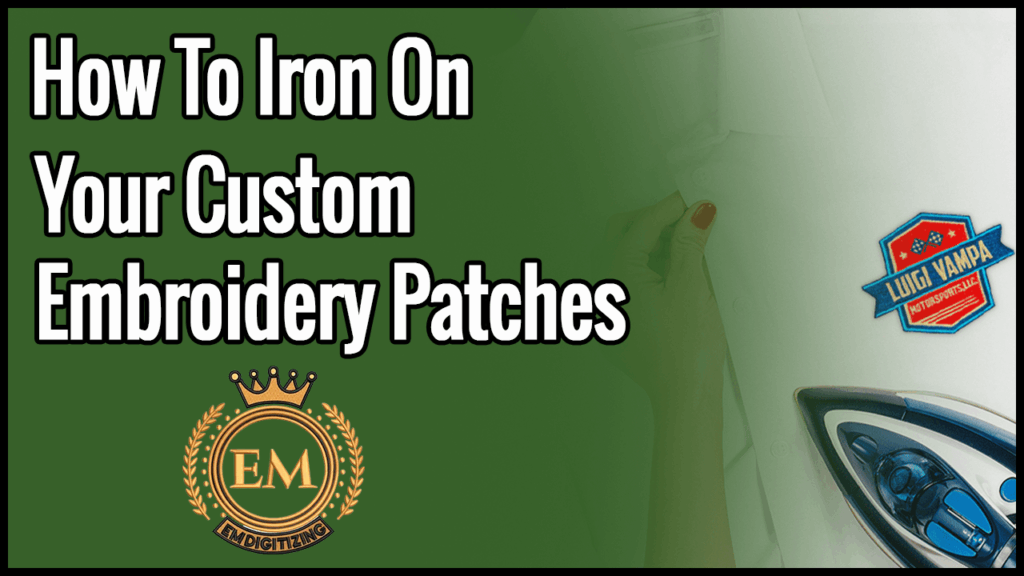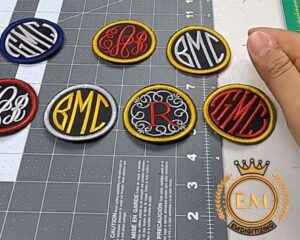How To Iron On Your Custom Embroidery Patches
In this article, we will discuss the process of ironing your custom embroidery patches. Embroidery patches are a popular way to add personality and flair to clothing items, bags, hats, and more. By following the simple steps outlined below, you can easily apply your custom patches to any fabric surface using just an iron. This guide will help you achieve a professional and long-lasting result, ensuring your custom embroidery iron on patches stay in place and look great for years to come.

How To Iron On Your Custom Embroidery Patches
Custom Embroidery Patches

Embroidery patches have been around for many years, and they continue to be a popular way to customize clothing, bags, hats, and other fabric items. If you have recently acquired custom iron on embroidered patches and want to attach them to your favorite item, you might be wondering how to do it.
Fortunately, ironing on a patch is a straightforward process that you can do at home using just a few simple tools. Let’s have a look at some of the steps required to iron on your custom embroidery patches, so you can wear your new accessory with pride!
What You Will Need To Custom Iron On Logo Patches:
- A fabric item to which you want to attach the patch
- Custom embroidery patches
- An iron
- An ironing board
- A thin towel or cloth
- A hard surface
Step 1: Preparing Your Fabric Item and Patch

Before you start, it’s important to make sure that the fabric item you want to attach the patch to is clean and dry. If it is not, wash and dry it before proceeding. This will ensure that the patch adheres to the fabric properly and stays in place for a long time.
Once your fabric item is clean and dry, place the custom embroidery patch on the area where you want it to be attached. You can use a pin to secure it in place temporarily, making sure it is centered and straight.
Step 2: Heating the Iron
Now it’s time to heat up the iron. Plug it in and set it to the temperature required for the fabric item you are attaching the patch. If you are unsure, consult the fabric’s care label. Wait for the iron to heat up before proceeding.
Step 3: Preparing the Towel
Place a thin towel or cloth on top of the patch. This will protect the patch from the heat of the iron and prevent any damage to the fabric. It’s important to choose a thin towel or cloth so that heat can still penetrate through to the patch.
Step 4: Ironing the Patch
Place the iron on top of the towel and press down firmly for about 15 seconds. Make sure you apply even pressure to the entire patch, including the edges. The amount of time required to iron on the patch may vary depending on the manufacturer’s instructions, so be sure to check before starting.
Once you’ve ironed the patch for the required amount of time, carefully lift up the iron and towel to check that the patch has adhered properly. If it hasn’t, you can repeat the process, making sure to apply more pressure or heat as needed.
Step 5: Ironing the Back of the Fabric Item
Once the patch is attached to the front of the fabric item, it’s time to iron the back to ensure a strong bond. Flip the fabric item over and place the towel on top of the patch again. Press down firmly with the iron for an additional 15 seconds.
Step 6: Checking the Patch
After ironing the patch, remove the towel and check to see if the patch is firmly attached. If it is not, repeat the process, making sure to apply more pressure or heat as needed. If the patch looks good, let it cool for a few minutes before wearing or washing the fabric item.
Step 7: Finishing Touches
Congratulations, you have successfully ironed on your custom embroidery patch! Depending on your preference, you may choose to add additional stitches around the edges of the patch to secure it further. Alternatively, you may want to leave it as is for a more casual look.
How To Clean Embroidered Patches?

Embroidered patches can add a lot of personality and style to your clothes or accessories, but they can also get dirty or stained over time. Here is how to clean embroidered patches:
Spot Cleaning:
If your patch has a small stain or mark, you can try spot-cleaning it with a damp cloth or sponge. Use a gentle soap or detergent and avoid rubbing too hard on the patch, as this can cause the embroidery to become damaged.
Hand Washing:
For larger or more delicate patches, hand washing is often the best option. Fill a sink/basin with mild hot water and add a detergent. Gently agitate the water to create suds, then add the patch and swirl it around in the water. Rinse the patch thoroughly with cool water and gently squeeze out any excess water.
Machine Washing:
Some custom embroidery patches may be able to be machine washed, but it’s important to check the care label and instructions before attempting this. Use a gentle cycle and a mild detergent, and make sure to place the patch in a mesh laundry bag to protect it from rubbing against other clothes or accessories.
Air Drying:
After washing your patch, avoid using a dryer or iron to dry it. Instead, lay it flat on a towel or drying rack and allow it to air dry completely. Avoid hanging the patch, as this can cause it to stretch or distort.
Professional Cleaning:
For very delicate or valuable embroidered patches, it’s often best to have them professionally cleaned. Look for a dry cleaner or laundry service that has experience with embroidery and be sure to let them know about any special care instructions or concerns.
Tips for Ironing on Your Custom Embroidery Patches:

Let’s have a look at some of the tips on your custom made iron on patches:
Test The Heat:
Before ironing on the patch, test the heat of your iron on a small, inconspicuous area of the fabric item. This will help you to avoid accidentally damaging the fabric with too much heat.
Use A Flat Surface:
Make sure to iron on a flat, stable surface. This will help you to apply even pressure to the patch and ensure that it adheres properly to the fabric.
Avoid Steam:
When ironing on the patch, make sure to turn off the steam function on your iron. Steam can cause the patch to shift or move, making it difficult to attach it properly to the fabric.
Trim Loose Threads:
Before ironing on the patch, make sure to trim any loose threads around the edges of the patch. This will help to prevent the threads from getting caught under the patch and causing it to lift up over time.
Avoid Pulling On The Fabric:
When attaching the patch to the fabric, avoid pulling on the fabric too much. This can cause the fabric to stretch or warp, which can affect the appearance of the patch.
Consider Sewing The Patch:
If you want to ensure that your custom embroidery patches stay in place for a long time, you may want to consider sewing it onto the fabric item in addition to ironing it. This can help to provide extra support and prevent the patch from coming loose.
Winding Up:
This was a simple guide on how to iron on your custom embroidery patches. Remember to follow the steps carefully and take note of the tips to ensure a successful application!
If you’re looking for professional embroidery logo digitizing services, EM DIGITIZING is a great option to consider. We offer high-quality services and even provide a discount for first-time customers. Feel free to reach out to us for a free quote.
We hope that you found this article informative and useful.
Yes, patches are cheaper than embroidery because they are made using a different process and can be produced in larger quantities at a lower cost. However, it ultimately depends on the specific embroidery design and manufacturing process used.
The cost of custom patches will depend on various factors, such as the size, design, quantity, and materials used. Generally, the more complex the design and the smaller the quantity, the higher the cost. Prices can range from a few dollars per patch for simple designs and large quantities, to several dollars per patch for more intricate designs and smaller quantities.
Yes, you can glue embroidered patches to fabric using fabric glue or adhesive.
The best stitch for embroidery patches depends on the design and the desired effect. Some popular stitches for patches include satin stitch, which creates a smooth and solid fill, and outline stitch, which outlines the design and creates a raised effect. Other stitches such as chain stitch, running stitch, and French knots can be used to add texture and detail.
Embroidered patches can stay on for a long time if they are properly attached to the fabric using sewing or ironing. Sewing is the most secure method, but ironing can also work well for many patches.
